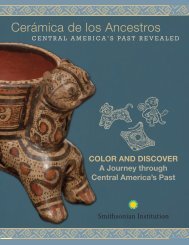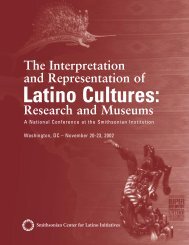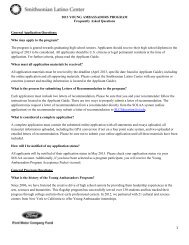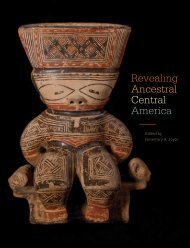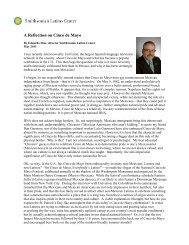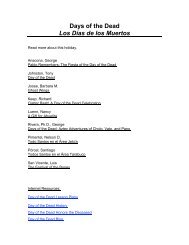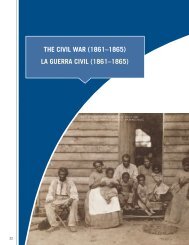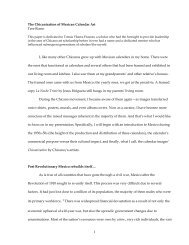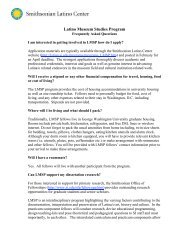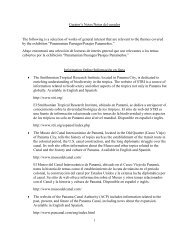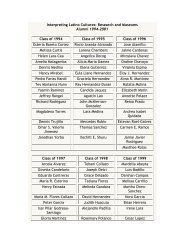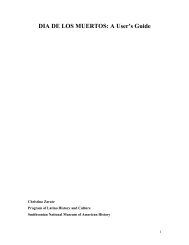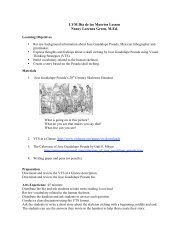smithsonian latino art collections - Smithsonian Latino Center
smithsonian latino art collections - Smithsonian Latino Center
smithsonian latino art collections - Smithsonian Latino Center
You also want an ePaper? Increase the reach of your titles
YUMPU automatically turns print PDFs into web optimized ePapers that Google loves.
the homogenizing term Hispanics throughout and conflated citizens of the various countries with U.S.<br />
populations of Hispanic descent. It advocated for a public-private p<strong>art</strong>nership for possible initiatives<br />
such as cultural tourism development projects with the World Bank Group (International Bank for<br />
Reconstruction and Development - IBRD) and the Inter-American Development Bank (IADB);<br />
conferences, seminars and workshops on Hispanic cultural and economic development issues with the<br />
Organization of American States and the United States Agency for Development (USAID) and others as<br />
well as the <strong>Smithsonian</strong> p<strong>art</strong>icipation in the “1994 Summit of Hemispheric Presidents” [Summit of the<br />
Americas in Miami]; the development of a SI Associates Program in Latin America with a monthly<br />
magazine and public and educational programs; international technical assistance to cultural<br />
organizations in Latin America; local mentoring programs for state, county and city cultural councils,<br />
agencies and Hispanic groups “to promote the adaptive re-use of buildings for community centers and<br />
display of <strong>art</strong>ifacts;” 52 the establishment of the “Institute of the Americas” in collaboration with the<br />
Woodrow Wilson International <strong>Center</strong> for Scholars; an inventory of museum <strong>collections</strong> in the Americas<br />
and Europe to be used to identify objects for display in the U.S. and Latin America and with the<br />
sponsorship of ‘U.S. corporate interests;’ an international consortium of museums with Hispanic<br />
<strong>collections</strong> to coordinate new exhibitions; and support for the planned National Museum of the<br />
American Indian and the cultures of the border region. 53<br />
However, the <strong>Smithsonian</strong> Institution Task Force on <strong>Latino</strong> Issues, after meeting as a group 17<br />
times since April 1993, released its report three months after The Americas Endeavor preliminary<br />
guidelines. The Task Force’s report entitled Willful Neglect: The <strong>Smithsonian</strong> Institution and U.S. <strong>Latino</strong>s<br />
released on May 10, 1994 days before Secretary Adams was to step down, found the Institution to<br />
“display a pattern of willful neglect towards the estimated 25 million <strong>Latino</strong>s in the United States.” 54<br />
Moreover, the Task Force identified as a missed opportunity the lack of transformation of the<br />
Quincentenary Program into a “permanent and sustained <strong>Latino</strong> presence at the Institution…[adding<br />
that] no permanent, effective Hispanic programming emerged.” 55<br />
In the letter of transmittal accompanying the report, the Task Force reiterated its own<br />
responsibility as to “systematically analyze employment and recruitment patterns and statistics at the<br />
<strong>Smithsonian</strong> with regard to <strong>Latino</strong>s, inventory existing programs focusing on <strong>Latino</strong> issues, provide<br />
recommendations for change within the <strong>Smithsonian</strong> and oversee the implementation of<br />
recommendations.” 56 In addition, it summarized its findings and stated: “The <strong>Smithsonian</strong> Institution<br />
almost entirely excludes and ignores the <strong>Latino</strong> population of the United States. This lack of inclusion is<br />
glaringly obvious in the lack of a single museum facility focusing on <strong>Latino</strong> or Latin American <strong>art</strong>, culture,<br />
or history; the near-absence of permanent <strong>Latino</strong> exhibitions or programming; the very small number of<br />
<strong>Latino</strong> staff, and a minimal number in curatorial or managerial positions; and the almost total lack of<br />
<strong>Latino</strong> representation in the governance structure.” It added, “It is difficult for the Task Force to<br />
understand how such a consistent pattern of <strong>Latino</strong> exclusion from the work of the <strong>Smithsonian</strong> could<br />
have occurred without willful neglect.” 57<br />
The Task Force made recommendations for the creation of an oversight board to implement its<br />
conclusions within the following year and “to make <strong>Latino</strong> initiatives a permanent p<strong>art</strong> of the Institution,<br />
52 Ibid, p. 6-7.<br />
53 Ibid.<br />
54 <strong>Smithsonian</strong> Institution. <strong>Smithsonian</strong> Institution Task Force on <strong>Latino</strong> Issues. “Willfull Neglect: The <strong>Smithsonian</strong><br />
Institution and U.S. <strong>Latino</strong>s.” Report. Washington, DC: <strong>Smithsonian</strong> Institution, May 1994, p. ii<br />
55 Ibid<br />
56 Letter to Secretary Adams and Undersecretary Newman, May 10, 1994. Included in report. <strong>Smithsonian</strong><br />
Institution Archives, Record Unit 95-073, Box 1, Folder: Willful Neglect: The <strong>Smithsonian</strong> Institution ans U.S.<br />
<strong>Latino</strong>s, 1994.<br />
57 Ibid.<br />
16



